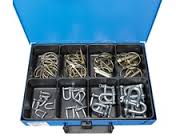Iron can be drawn into a wire. If you upset one side to a head, and sharpen the other end to a point, you have a nail. Bent nails are quiet (re) usable. You can easily knock them straight.
 You can avoid getting knocked on your fingers if you hold a nail with something else to beat him in: with a comb, a clothespin, a piece of cardboard, tweezers or forceps.
You can avoid getting knocked on your fingers if you hold a nail with something else to beat him in: with a comb, a clothespin, a piece of cardboard, tweezers or forceps.
If you want to pound- without bending (or breaking him) a nail in concrete or hard wood you need extra support by first beating him trough a cork.
A U-nail is an U- shaped curved barbell with sharp points. One leg is a little longer to make it easier to attach. Except for wire tacking such clamping brackets are also used to adhere to wounds or clamp two ends of leather or rubber drive belts to each other.
A staple is a small, usually bow-shaped, flattened piece of metal with two legs at 90 degrees in the same direction.
It is usually applied with a device (stapler) to attach materials together or to attach thin media (film) to a flat surface (stapling). The flat, long side of the staple tears less prone through the thin material than with a nail (small). For sheets of paper the arms of this small office article shall be folded back to the rear. It is also used to keep sheets of magazines together, to furnish..
A spring is a pre-formed strip of steel wire that by mechanical stress provides energy to return to a previous state.
The spring can be cylindrical (or non- conical):
At a compression spring you can compress the turns. They are mainly used to mute (pen, suspension, shock...) a movement
By a tension spring dense coils are pulled apart (weighing scale, motor)
At a torsion spring is the number of turns increased: windup clock, music,..
The German locksmith Peter Henlein invented a pocket watch around 1506. In it he used coil springs, which excited, can store energy to drive cogs and gears.
The Londoner Obadiah Elliot developped in 1804 the leaf spring. He mounted strips of steel together and attached them to the bottom of a carriage.
Clockmaker John Harrison (1693-1776, Yorkshire) coined the bimetal to correct variations in a balance spring. Two strips of different metals are attached firmly together. At a temperature change in the strip, it will bend through the various coefficient of expansion of the metals. With this can be made a bimetal thermometer or a thermal switch (thermostat).
The British engineer Henry Maudslay (1771-1831) standardized (screw) thread. Previously, there was a mixed bag where single pieces were made by piece and didn’t fit anywhere else. He also designed precision equipment to produce identical screws of the same pitch. A golden idea.
Today there are lock nuts: nuts containing a tight plastic ring so they cannot vibrate loose (e.g. on a machine). After removing the plastic pinches usually insufficient. Sometimes it is possible to re- squeeze by tapping in the edge with a chisel some 6 dents in the plastic.
You can also mount a spring washer under the nut.
Or you can (if the wire is long enough) run a second nut as a secure on top.
Or use glue as security against vibration loosening.
Or a rubber ring (gasket, rubber band).
A cotter pin is a double pleated metallic thread, the button (inflection point) is a thickened loop. A cotter pin is used to fasten two things to each other .The pins are inserted through the fitting holes and, on the other hand, bent from each other.
A cotter pin may also be used to cross a nut and screw thread to secure, or prevent the running off of a wheel from the hub.
Originally, the scissors did not pivot, but the two blades were connected to a resilient part, such as boxwood or sheep shearing scissors (a 90⁰ twisted 3, with blades on the outer ends, but an upright 8 could also: open top, with blades to top).
